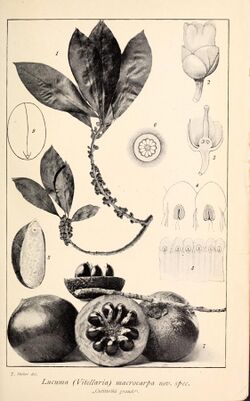Biology:Pouteria multiflora
| Pouteria multiflora | |
|---|---|

| |
| Scientific classification | |
| Kingdom: | Plantae |
| Clade: | Tracheophytes |
| Clade: | Angiosperms |
| Clade: | Eudicots |
| Clade: | Asterids |
| Order: | Ericales |
| Family: | Sapotaceae |
| Genus: | Pouteria |
| Species: | P. multiflora
|
| Binomial name | |
| Pouteria multiflora | |
| Synonyms | |
Pouteria multiflora is a plant in the family Sapotaceae of the order Ericales.[1][2] Its English common name is bullytree.[4] Its Spanish common names include jácana,[5] ácana, acana, hacana, or jacana. It is native to North and South America.[6][4] The plant is common in the Toro Negro State Forest.[7]
It can grow from 40–90 feet (12–27 m) high and from 2–3 feet (0.61–0.91 m) in diameter. It yields very good timber that can be used for mill rollers, frames, furniture, and house building. Acana wood is light colored, fine and straight grained, hard, very heavy, strong, durable, and can be polished to shine. The pores are small and arranged in radial rows. Pith rays narrow and indistinct.[8]
A similar definition of the Acana tree is given by Constantino Suarez in his Diccionario de voces Cubanas as; wild indigenous tree with a straight trunk that grows to 10 meters with coriaceous rigid oval leaves which produces a nutritious fruit smaller than the zapote, and whose wood is valued in Cuba for rustic houses and ship building because of the wood's durability and hardness, qualities enhanced by its sonority, weight, and beautiful reddish color.[9]
Acana in the arts
- Poem: "Song of the Acana Tree" (Spanish: Canto del Acana) by Minerva Salado[10]
- Poem: "Acana" by Cuban writer Nicolás Guillén[11]
- Music: "Acana", by Cuban composer Tania León[12]
References
- ↑ 1.0 1.1 1.2 1.3 1.4 Pouteria multiflora (A.DC.) Eyma. The Plant List. Retrieved 12 September 2013.
- ↑ 2.0 2.1 Pouteria multiflora (A. DC.) Eyma; Taxonomic Serial No.: 23838. ITIS Report. Taxonomic Serial No.: 32224. Integrated Taxonomic Information System. White House Subcommittee on Biodiversity and Ecosystem Dynamics. USGS Reston, VA. Retrieved 12 September 2013.
- ↑ !Pouteria multiflora (A. DC.) Eyma. Tropicos. Retrieved 12 September 2013.
- ↑ 4.0 4.1 Pouteria multiflora (A. DC.) Eyma; bullytree. USDA. Natural Resources Conservation Service. Plants Database. Retrieved 12 September 2013.
- ↑ Pouteria multiflora A.DC. Eyma: Sapotaceae - Sapodilla family. John A. Parrotta and John K. Francis. USDA. Forest Service. Publication Number: SO-ITF-SM-62. August 1993. Retrieved 12 September 2013.
- ↑ Grandtner, M. M.; Chevrette, Julien (2013) (in en). Dictionary of Trees, Volume 2: South America: Nomenclature, Taxonomy and Ecology. Academic Press. pp. 527. ISBN 9780123969545.
- ↑ Bosques de Puerto Rico: Bosque Estatal de Toro Negro. Hojas de Nuestro Ambiente. July 2008. [Publication/Issue: P-030] Puerto Rico Department of Natural and Environmental Resources. (in Spanish) Retrieved 12 September 2013.
- ↑ Bulletin of the U.S. Department of Agriculture. Department of Agriculture. 1917. pp. 4–. https://archive.org/details/bulletinusdepar00agrigoog.
- ↑ Gustavo Pérez Firmat (June 15, 1989). The Cuban Condition: Translation and Identity in Modern Cuban Literature. Cambridge University Press. pp. 107–. ISBN 978-0-521-32747-3. https://archive.org/details/cubanconditiontr0000pere.
- ↑ Catherine Davies (1997). A Place in the Sun?: Women Writers in Twentieth-Century Cuba. Zed Books. pp. 169–. ISBN 978-1-85649-542-4. https://books.google.com/books?id=X2xiRtjF8RkC&pg=PA169.
- ↑ Gustavo Pérez Firmat (June 15, 1989). The Cuban Condition: Translation and Identity in Modern Cuban Literature. Cambridge University Press. pp. 106–. ISBN 978-0-521-32747-3. https://archive.org/details/cubanconditiontr0000pere.
- ↑ Bernard Holland (April 3, 2008). "An Ensemble Finds Unity With a Seasoned Soprano". The New York Times. https://www.nytimes.com/2008/04/03/arts/music/03orph.html?ex=1364961600&en=4f6a0cba9ef40237&ei=5124&partner=permalink&exprod=permalink&_r=0.
Wikidata ☰ Q15328832 entry
 |

